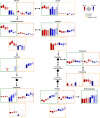The maturity in fetal pigs using a multi-fluid metabolomic approach
- PMID: 33199811
- PMCID: PMC7670440
- DOI: 10.1038/s41598-020-76709-8
The maturity in fetal pigs using a multi-fluid metabolomic approach
Abstract
In mammalian species, the first days after birth are an important period for survival and the mortality rate is high before weaning. In pigs, perinatal deaths average 20% of the litter, with important economic and societal consequences. Maturity is one of the most important factors that influence piglet survival at birth. Maturity can be defined as the outcome of complex mechanisms of intra-uterine development and maturation during the last month of gestation. Here, we provide new insights into maturity obtained by studying the end of gestation at two different stages (3 weeks before term and close to term) in two breeds of pigs that strongly differ in terms of neonatal survival. We used metabolomics to characterize the phenotype, to identify biomarkers, and provide a comprehensive understanding of the metabolome of the fetuses in late gestation in three fluids (plasma, urine, and amniotic fluid). Our results show that the biological processes related to amino acid and carbohydrate metabolisms are critical for piglet maturity. We confirm the involvement of some previously described metabolites associated with delayed growth (e.g., proline and myo-inositol). Altogether, our study proposes new routes for improved characterization of piglet maturity at birth.
Conflict of interest statement
The authors declare no competing interests.
Figures




References
-
- UNICEF, WHO, World Bank Group and United Nations. Levels and trends in child mortality 2019. Estimates developed by the UN Inter-agency group for child mortality estimation. Tech. Rep., UN-IGME (2019). 10.1016/S0301-6226(98)00147-X. https://www.unicef.org/reports/levels-and-trends-child-mortality-report-....
-
- Edwards S, Baxter E. Piglet mortality: causes and prevention. In: Farmer C, editor. The Gestating and Lactating Sow. Wageningen: Academic Publishers; 2015. pp. 253–278.
Publication types
MeSH terms
LinkOut - more resources
Full Text Sources
Medical

